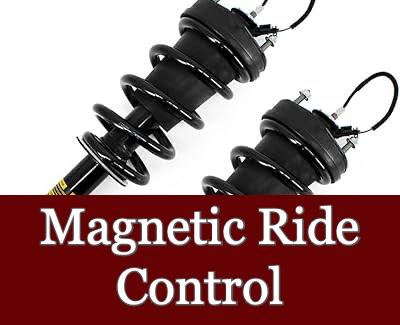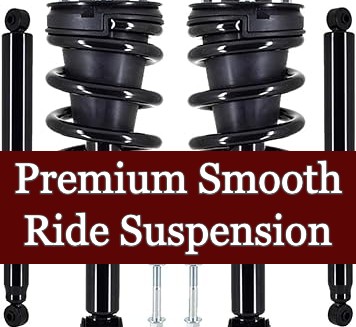As automotive technology continues to advance, the Magnetic Ride Control and Premium Smooth Ride suspension debate has become a topic of intense discussion among car enthusiasts and industry experts.
Magnetic Ride Control, developed by General Motors in collaboration with Delphi Automotive Systems, utilizes magneto-rheological fluid in the shock absorbers to continuously adjust damping levels based on real-time road conditions. Meanwhile, GM’s Premium Smooth Ride system combines self-leveling rear shocks with specially tuned springs to provide a smooth and stable ride under varying load conditions.
This debate delves into the intricate engineering behind these technologies, their impact on driving dynamics, and their ability to deliver an unparalleled level of comfort for passengers. But what should be your choice? Let’s understand the differences and benefits of each to discover which is right for an optimal blend of comfort and performance on today’s roads.
What is Magnetic Ride Control?

Magnetic Ride Control (MRC) is a cutting-edge automotive technology that revolutionizes the driving experience by delivering an incredibly smooth and precise ride. Unlike traditional suspension systems, MRC uses magnetorheological fluid-filled shock absorbers that contain tiny iron particles.
These particles respond to changes in the magnetic field instantly, allowing the system to adjust the firmness of the dampers within milliseconds. This means that MRC can adapt to changing road conditions on the go, ensuring optimal comfort and handling at all times.
One of the key advantages of Magnetic Ride Control is its ability to provide exceptional performance without sacrificing comfort. By constantly monitoring and adjusting damping levels, the system helps keep the vehicle level and composed, even during aggressive cornering or sudden maneuvers.
What is Premium Smooth Ride Suspension?

The Premium Smooth Ride suspension is a standard feature in the 2021 Chevrolet Tahoe for commercial models, LS, LT, RST, and Z71. This innovative suspension system is engineered to enhance driving comfort by minimizing the impact of rough road conditions on the interior cabin.
In practice, the Premium Smooth Ride suspension accomplishes this by employing a conventional front suspension while incorporating a self-contained, self-leveling Nivomat shock in the rear. This combination effectively isolates occupants from the jolts and bumps typically experienced on uneven surfaces.
The Nivomat shock specifically adapts to varying load conditions, automatically adjusting to maintain optimal ride quality no matter the cargo or passenger weight. As a result, drivers and passengers can enjoy a consistently smooth ride regardless of what they’re carrying or where they’re headed.
Magnetic Ride Control vs Premium Smooth Ride Suspension: Key Differences
Certain factors help in evaluating any suspension system for our vehicles. We have set those factors as an evaluation scale to determine the effectiveness and potential differences between these two suspension systems.
Performance and Handling
The Magnetic Ride Control offers unparalleled responsiveness and agility, providing a truly dynamic driving experience. It has been praised for its ability to adapt to varying road conditions instantaneously, providing a smooth and controlled ride without sacrificing performance.
On the other hand, the Premium Smooth Ride Suspension offers a more traditional approach, focusing on comfort and stability rather than advanced adaptive capabilities.
In terms of handling, the Magnetic Ride Control shines with its ability to adjust damping levels in real time, enhancing cornering stability and reducing body roll. This technology gives drivers a sense of confidence and control even when taking on challenging twists and turns.
Alternatively, the Premium Smooth Ride Suspension may offer a more luxurious feel on straight roads but can struggle to match the dynamic responsiveness offered by magnetic ride technology during spirited driving.
Comfort and Ride Quality
The Magnetic Ride Control offers a dynamic response to varying road conditions, using electromagnetically controlled shock absorbers for superior ride comfort and stability. On the other hand, Premium Smooth Ride Suspension aims to deliver a plush and luxurious driving experience by minimizing harsh impacts and vibrations, particularly over uneven surfaces.
While both suspension systems excel in providing a comfortable ride, it’s important to address how they impact handling dynamics. The Magnetic Ride Control emphasizes sporty responsiveness without compromising comfort, making it an ideal choice for enthusiasts seeking performance-oriented driving dynamics.
Conversely, Premium Smooth Ride Suspension prioritizes serene cruising experiences with gentle body motions and minimal disturbances, catering to drivers who value tranquility on long journeys.
Cost and Maintenance
As consumers weigh their options between these two technological marvels, it becomes clear that considering both initial cost and long-term maintenance needs is crucial for making an informed decision.
While the initial cost of vehicles equipped with Magnetic Ride Control may be higher, the long-term maintenance benefits cannot be overlooked. The adaptive nature of the system reduces wear and tear on traditional mechanical components, potentially leading to lower maintenance costs over time.
Furthermore, in terms of maintenance, the Magnetic Ride Control system typically requires less frequent replacement or servicing compared to traditional suspension setups. This is due to its electronic control system, which can proactively address issues before they become major problems.
On the other hand, while premium smooth-ride suspension systems offer excellent comfort, they may require more frequent maintenance due to their reliance on standard shock absorbers and springs.
Load Capacity and Adjustability
With the Nivomat shock inside premium smooth ride suspension, this system automatically adjusts to varying loads, providing a consistently smooth ride regardless of weight distribution. This passive system offers an impressive level of adaptability without requiring any input from the driver, making it a convenient option for those seeking a hassle-free driving experience.
On the other hand, magnetic ride control utilizes electromagnetically adjustable shocks to provide real-time damping adjustments. This active suspension system allows for precise customization, catering to various driving conditions and preferences.
The ability to rapidly adapt to changing road surfaces and driver inputs delivers an outstanding balance between comfort and performance. In essence, while the Nivomat shock excels in autonomous load-sensing adjustability, magnetic ride control takes personalization to new heights with its dynamic responsiveness.
Suitability
While both systems aim to enhance the driving experience, they cater to different needs. For instance, the Premium smooth ride suspension prioritizes comfort and load-bearing capability, while Magnetic Ride Control excels in agility and responsiveness.
The Premium smooth ride suspension is typically found in larger GM vehicles such as the Cadillac Escalade, Chevrolet Tahoe, and GMC Yukon. This system works by automatically adjusting the damping force of the shocks based on road conditions, providing a smooth and stable ride even when carrying heavy loads or towing.
On the other hand, Magneride suspension is often featured in high-performance models like the Chevrolet Corvette, Cadillac CTS-V, and GMC Sierra Denali. The magnetic ride control offers incredibly responsive handling by instantly adapting to changes in road surfaces and driving conditions, delivering a dynamic driving experience without compromising on comfort.
Pros and Cons of Magnetic Ride Control
To pick the best one among many options, the wisest approach is to weigh their pros and cons. So, we have pointed out the notable pros and cons of Magnetic ride control suspension below. Check them.
Pros:
- Offers superior ride quality and comfort due to real-time damping adjustments.
- Enhances handling and stability by instantly adapting to driving conditions.
- Reduces body roll and improves cornering ability for a more controlled driving experience.
- Provides a smoother ride over rough roads, enhancing overall driving comfort.
- Increases vehicle performance by adjusting suspension settings based on road surfaces and driving dynamics.
Cons:
- Can be expensive to repair or replace if components fail outside of warranty coverage.
- Relies on complex electronic components that may be susceptible to failure in some cases. Check the most common issues regarding Magnetic ride control.
- Potential for decreased reliability in extreme temperature conditions or harsh environments.
Pros and Cons of Premium Smooth Ride Suspension
Now let’s have a look at the positive and negative sides of GM’s premium smooth ride suspension:
Pros:
- Provides a smooth and comfortable ride, minimizing bumps and jolts.
- Automatically adjusts to varying road conditions for improved handling and stability.
- Enhances towing and hauling capabilities with consistent suspension performance.
- Helps minimize body roll during cornering, improving overall handling dynamics.
- Nivomat shocks adjust to load changes, ensuring optimal ride quality regardless of cargo or passengers.
Cons:
- Limited aftermarket upgrade options compared to other suspension systems.
- Replacement parts can be more expensive due to the specialized nature of the system.
- Possibility of reduced off-road capability due to softer spring rates and limited articulation.
Conclusion
MRC’s adaptive nature allows for instantaneous adjustments based on sensor inputs, ensuring an incredibly responsive and refined driving experience. In contrast, ZW7’s focus on load management might provide more predictable handling under heavy payloads but could potentially lack the nuance of MRC’s dynamic responsiveness.
While both systems offer distinct advantages, their effectiveness ultimately depends on individual preferences and driving scenarios. Magnetic Ride Control excels at delivering precise handling and adaptability to varying road surfaces, making it ideal for drivers seeking an engaging and dynamic driving experience.
Conversely, GM’s Premium Smooth Ride Suspension shines in providing exceptional comfort over long distances or during towing applications, where maintaining stability and minimizing body roll is paramount.
